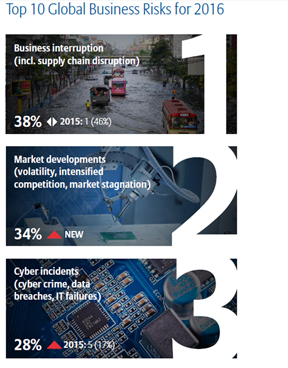The risk landscape for businesses is substantially changing in 2016. While businesses are less concerned about the impact of traditional industrial risks such as natural catastrophes or fire, they are increasingly worried about the impact of other disruptive events, fierce competition in their markets and cyber incidents. These are key findings of the Allianz Risk Barometer 2016, the fifth annual survey on corporate risks published by Allianz Global Corporate & Specialty (AGCS), which surveyed over 800 risk managers and insurance experts from more than 40 countries.
According to the Allianz Risk Barometer business and supply chain interruption (BI) remains the top risk for businesses globally for the fourth year in succession. However, many companies are concerned that BI losses, which usually result from property damage, will increasingly be driven by cyber-attacks, technical failure or geo-political instability as new “non-physical damage” causes of disruption. Meanwhile, two of the major risers in this year’s Allianz Risk Barometer feature in the top three corporate risks for the first time with market developments ranking second and cyber incidents third. Cyber incidents are also cited as the most important long-term risk for companies in the next 10 years. In contrast, natural catastrophes drops two positions to fourth year-on-year, reflecting the fact that in 2015 losses from natural disasters reached their lowest level since 2009.
“The corporate risk landscape is changing as many industrial sectors are undergoing a fundamental transformation,” explains AGCS CEO Chris Fischer Hirs. “New technologies, increasing digitalization and the ‘Internet of Things’ are changing customer behavior, industrial operations and business models, bringing a wealth of opportunities, but also raising awareness of the need for an enterprise-wide response to new challenges. As insurers we need to work together with our corporate clients to help them to address these new realities in a comprehensive manner.”
Challenging market environment
More than a third of responses (34%) cited market developments such as intensified competition or market volatility/stagnation as one of the three most important business risks in 2016, ranking this new survey category1 as the second top peril overall. Market developments are a particular concern in the engineering, financial services, manufacturing, marine and shipping, pharmaceutical and transportation sectors, where this risk ranks among the top three business risks respectively. In addition, this risk ranks as a top two concern in Europe, Asia-Pacific and Africa & Middle East.
Many businesses are facing a growing number of challenges which threaten their profitability and possibly also their business models. “Businesses constantly have to be on their toes, turning out new products, services or solutions in order to stay relevant to the customer and to thrive in this rapidly changing and globally competitive environment,” explains Bettina Stoob, Head of Innovation at AGCS. “Innovation cycles are becoming rapidly shorter; market entry barriers are coming down; increasing digitalization and new “disruptive” technologies have to be quickly adopted while potentially more agile start-ups are entering the game.” At the same time businesses are also having to comply with changing or enforced regulation, increasing safety requirements or import/export restrictions.
Rising sophistication of cyber attacks
Another area of increasing concern for businesses globally are cyber incidents which includes cyber-crime or data breaches, but also technical IT failures. Cyber incidents gained 11 percentage points year-on-year to move from fifth position into the top three risks for the first time (28% of responses). Five years ago, cyber incidents were identified as a risk by just 1% of responses in the first Allianz Risk Barometer. Loss of reputation (69%) is the main cause of economic loss for businesses after a cyber incident, according to responses, followed by business interruption (60%) and liability claims after a data breach (52%). Companies are increasingly concerned about the growing sophistication of cyber-attacks, according to the Allianz Risk Barometer. “Attacks by hackers are becoming more target-oriented, lasting for longer and can trigger a continuous penetration”, explains Jens Krickhahn, cyber insurance expert at AGCS. While cyber-attacks are increasing both in frequency and severity, companies should not underestimate the impact of an operational failure in today’s highly digital and connected industries. “A simple technical failure or user error can result in a major IT system outage disrupting supply chains or production,” says Volker Muench, AGCS expert for property underwriting. “Early warning and better monitoring systems are necessary in order to prevent large cyber BI losses,” says Krickhahn.
Geo-political instability causing disruption
BI remains the top peril in the Allianz Risk Barometer for the fourth year in succession with 38% of responses. Indeed BI losses for businesses are increasing, typically accounting for a much higher proportion of the overall loss than a decade ago and often substantially exceeding the direct property loss, as AGCS insurance claims analysis shows. According to responses, major causes of BI feared most by companies are natural catastrophes (51%), closely followed by fire/explosion (46%). However, according to the survey’s findings, multinational companies are also increasingly worried about the disruptive impact of geo-political instability as war or upheaval could impact their supply chains or their staff or assets could suffer from acts of terrorism.
“Businesses need to prepare for a wider range of disruptive forces in 2016 and beyond,” says Axel Theis, Member of the Board of Management, Allianz SE. “The increasing impacts of globalization, digitalization and technological innovation pose fundamental challenges.”
Specific risk profiles for regions and sectors
On top of regional analysis the Allianz Risk Barometer also explores sector-specific risks, for example for manufacturing, marine & shipping and other major industries.
1In the 2015 Allianz Risk Barometer market developments risks were ranked separately, not as one collective peril
